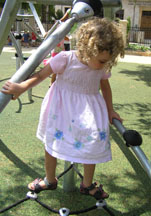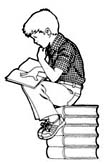1.38 הגִייָה - PRONUNCIATION
The American who wishes to achieve an acceptable Israeli accent must devote special attention to the vowels, intonation, and diction.
1.38.1 הגִייָה - Vowels -
Hebrew vowels are "tense". In other words, the mouth muscles are held in a firm position, which does not vary during the pronunciation of the syllable. In American English, the quality of the vowels may change during pronunciation. Pronounce the English words as they are transcribed after the equal signs. Then try to pronounce the Hebrew syllable without changing the vowel quality.
 cool = /coo-wel/ vs
cool = /coo-wel/ vs
call = /caw-el/ vs
קולpeel = /pee-el/ vs
פילYou may find it useful to practice imitating a heavy Israeli accent in English to get the feel of the Hebrew vowels. To get the "feel" of the Hebrew.
/eet iz yoosfull tuh dry eet!/
Intonation 1.38.2
Every language has a melody. Sometimes if you are within earshot of a conversation but not close enough to actually hear the words clearly, you can tell if the people are speaking English, French, Spanish, or German. Why is that so? Because each language has its own rhythm or cadenced as well as its melodic characteristics. Try to use the Hebrew melody. Use the audio recordings and your instructor as models. However, do not expect to acquire an Israeli accent solely by listening. Pronunciation skill is acquired through interacting with other speakers -- not merely by listening.
Your accent is an important part of what you are learning. And while it is not the most important aspect of your Hebrew study, you can be sure that Israelis will appreciate your attempt to master the accent. Moreover, it can actually influence how Israelis judge your Hebrew ability and whether they will answer you in Hebrew or not!
Diction 1.38.3
Spoken language is not the same as written language. Spoken sentences do not have spaces between the words as they do on paper. The words are often run together so that several words sound like one. Look at these two versions of the same sentence:
/MAH-t OMEH-ret/ =
מת ומֶרֶת/MAH at oh-MEH-reht/ =
מה את אומֶרֶת53

Note that slight pauses may occur in a sentence, often in the middle of a word. This is common in casual or rapid speech among native speakers of Israel. You will need to "tune" your ears to hear the individual words within the stream of the sentence, in order to understand authentic Israeli Hebrew. Now think about the two kids in an American high school who are running down the hallway during the noon hour ... Here's what you might hear:
"Hay jeet yet?"
"No, Ju?"
(Translation: Hey, did you eat yet? No, did you?)
1.39
דיקדוּק
1.39.1
שְמות עֶצֶם ומין
- The Gender of Nouns -
(See
also ¶2.20) and Chapter 1: 5 "Spelling & the Order of the
Alphabet"
Hebrew nouns are either masculine
gender מין זכר
(The word מין
means both "gender" and "sex".)![]() Use with Software Chapter 1:13
"Gender Agreement With Nouns & Adjectives"
Use with Software Chapter 1:13
"Gender Agreement With Nouns & Adjectives"
Nouns that end in an /ah/ vowel and whose last letter is a ה, or nouns that end with a ת are generally מין נְקֵבה.
100.00 %
Here are some feminine nouns
כיתה תלְמידה שירה מחְבֶּרֶת
סְטוּדֶנְטית עבְרית סְליחה
Here are some masculine nouns:
בוקֶר עיפּרון שיר סוף
לוּחַ סֵפֶר סְטוּדֶנְט עמוּד
The vocabulary lists at the end of each chapter indicate the grammatical gender of nouns with an abbreviation
: נ = נְקֵבה and ז = זכר54
Agreement of Adjective and Nouns 1.39.2
![]() Use with Software Chapter 1 "Drill On
Adjectives of Mixed Gender"
Use with Software Chapter 1 "Drill On
Adjectives of Mixed Gender"
Watch what happens to adjectives when they refer to a
feminine noun. See how their form changes from the form of a masculine
noun.


100.00 %
ז
= זכר Masculine נ = נְקֵבה Feminineתלְמיד טוב
a good student כיתה טובה a good classסֵפֶר טוב
a good book דינה תלְמידה טובה Dina is a good studentשבוּעַ טוב a good week זֹאת כִיתה גְדולה This is a big class
1.39.3 לְמלֵא אֶת הֶחסֵר Fill in the Blanks
Pretend that this is a conversation between a man and woman. She happens to say to him that he is a good man and he immediately responds that she is a good woman. From then on it was back and forth. Whatever was said about a man was then applied to a woman and vice versa. You fill in the responses .
100.00 %
אתה איש (man) טוב כֵּן, וגם את אישה טובה
1. הוּא סְטוּדֶנְט חדש כֵּן, וגם היא ___________________________
2. אני מורֶה מְצוּיין כֵּן, וגם אני מצוּיֶינֶת ___________________
3. הוּא תלְמיד פּׂה כֵּן, וגם היא _____________________________
4. הוּא איש אמֶריקאי כֵּן, וגם היא (אמריקאית) ____________________
5. אני גדול מְאוד כֵּן, וגם אני ______________________________
6. אני איש נעים כֵּן, וגם אני ______________________________

55
1.40 כְללים RULES
1. The Hebrew adjective always follows the noun it describes.
100.00 %
מין זכר מין נקבה
בוקֶר טוב
שירה טובהgood poetry good morning
2. The gender
(מין) of the adjective must always be the same as that of the noun it describes. If the Hebrew noun is masculine, the adjective must also be masculine. This "matching" is called agreement.100.00 %
תלְמיד טוב
תלְמידה טובה(a good student (f) a good student (m
3. The number
(מיסְפּר) singular or plural, of the adjective must always be in agreement with the noun it describes.100.00 %
תלְמיד טוב
תלְמידה טובהתלְמידים טובים תלְמידות טובות
4a. Grammatical Terms
When the noun refers to something specific, known, or unique, it will have the letter ה in front of the noun. Example "the notebook". The term for this sort of noun is a definite noun.
The adjective that follows that noun must also begin with a ה. We will work on this more in the following chapters. When a noun has "the"
ה attached to it then the adjective must also have the ה attached to it. Examples:100.00 %
הבוקר הטוב the good morning ֬המחְבֶּרת הקְטנה the small notebook
הלוּחַ הגדול the big board
השירה החדשה the new poetry
4b. The opposite of a definite noun is an indefinite noun: Example: "a notebook"
סֵפֶר טוב a good book מחְבֶּרת קְטנה a small notebook
5.. Hebrew likes to keep the accent at the end of the word. Notice what happens to the masculine form of most two-syllable adjectives when a feminine or plural ending is added. Study these examples.
100.00 %

סֵפֶר קטן כיתה קְטנה
בוקֶר נעִים כיתה
נְעימה
סֵפֶר גדול כיתה גְדולה
תלְמיד גדול תלְמידים גְדולים
Did you notice that /ka-tan/
קטן becomes /k'taNA/ and not */ka-ta-na?You see that we changed the vowel of the first syllable from
קָ to קְHow to pronounce the
שְוואHere are a few more examples of how the vowel in the first syllable is "shortened." Israelis usually eliminate that first vowel completely! Watch this:
תפּוּחַ שָלֵם -
ta-pu-ax sha-LEHM אֲרוּחָה שְלֵמָה - ah-ru-xa sh-leh-MAa whole meal a whole apple
בוקֶר נעִים כיתה נְעימה
Sometimes it's impossible to pronounce the first syllable without a vowel and then the
שְווא must be pronounced. Here are two examples:סֵפֶר גדול -
/SEH-fehr ga-DOHL/ כיתה גְדולה - /ki-TAH ge-dohl-LAH
(You will find that when you speak quickly you might say: ki-TAG doh-LAH—just like the Israelis do when they talk fast!)
56
Finally, let's notice that the same thing happens when the adjective is masculine plural - מין זכר
תלְמיד שָקֵט - a quiet student תלְמידים שְקֵטים - quiet students
In the feminine form (מין נְקֵבה) of the adjective, notice how the accent shifts to the new last syllable, and the vowel of the first syllable almost disappears. The "zero-vowel" (no vowel at all!) is written as a sheva שְווא
תלְמידה שְקֵטה תלְמידות שְקֵטות .
NOTE: At this point you are not expected to memorize these rules.It's just important for you to begin to recognize and expect the changes in the forms of the adjectives that you hear in your instructor's speech or you see in the texts you read. Just remember ...
Not matching the gender and number of adjectives is a serious error in Hebrew
!Challenge: Can you create a general rule about forming the plurals of masculine and feminine nouns? (You will learn the rule later... This question is for those who like puzzles.)
1.40.1
למלא את החסר
Below is an exercise in changing adjectives from masculine
form to feminine form. Remember that the vowel in most two-syllable adjectives
are changed to a
100.00 %
.
.
2 תלמיד גבוהַּ תלמידה _______________________________.
3 סֵפֶר שחור מחְבֶּרֶת ________________________________.
4 איש עיֵיף אישה __________________________________.
5 עמוּד קטן מחְבֶּרֶת ________________________________.
6 סֵפֶר קצר שוּרה ___________________________________.
7 סֵפֶר שחור מחְבֶּרֶת ________________________________100.00 %
*with answers
57
1.40.2 מין זכר - מין נְקֵבה
Study these pairs of sentences. Watch the changes.
100.00 %
מין זכר
מין נְקֵבה

דן תלְמיד טוב דינה תלְמידה טובה
הִינֵה סֵפֶר קטן הִינֵה כִּיתה קְטנה
זֶה שיר ארוך זאת שוּרה אֲרוּכּה
זֶה לא שיר נעים זאת לא מורה נְעימה
שֵיער ארוך וְיפֶה מחְבֶּרֶת גְדולה וְיפה
1.40.2.1
אֵיפׂה אַתְ גרה? אֵיפׂה אתה גר?
Gil, an Israeli and Ruth, an American who settled in Israel have just met.
1.40.3
תרְגיל תירְגוּם
Translate the following sentences
into English. Indicate (
גיל:
רות, תגידי, אֵיפׂה אתְ גרה? בִירוּשלים?
רוּת:
לׂא, לׂא. פעם גרְתי בִירוּשלַיִם (אני נולדְתי בְשיקאגו) ועכְשיו אני גרה בְאֵילת.
גיל:
בְאֵילת! חם מְאוד שם.
רוּת:
כֵן, חם מְאוד. אבל לׂא תמיד. וְאתה, אֵיפׂה אתה גר?.
גיל:
עכְשיו אני גר בְתֵל אביב, אבל נולדְתי בגליל, בִטְבֶרְיה
רוּת:
בִטְבֶרְיה—על-יד הכִּנֶרֶת. גם שם חם מְאוד.
גיל:
נכון, אבל לׂא תמיד.
שֵם יפֶה
_______________________
תלמיד טוב
_______________________תלמידה טובה
_______________________מילה חדשה
_______________________שיר חדש
_______________________כיתה נעימה
_______________________תלמידות טובות תלמידים טובים
_______________________Translate the following sentences into Hebrew.
A new book ______________________________
A good class ______________________________
A small blackboard (whiteboard) ______________________________
A small blackboard (whiteboard) ______________________________
1.41.1 ה At The End Of A Word
- At The End Of A Word - ה "Consonantal"1.41.2
Look carefully at these sentences
100.00 %

הוּא תלְמיד גבוהַּ
He is a tall studentהיא תלְמידה גְבוהָה She is a tall student
יש
יש
סְפרים
יפים
בּ
The word גבוהַּ - "tall" is a useful word. Notice the dot in the ה for "הוּא תלְמיד גבוהַּ " That dot (called a /ma-pik/ מפּיק) tells you that here the ה is part of the basic root of the word and can't be dropped when changing the form of the word to feminine or plural. The next line - "She is a tall student " היא תלְמידה גְבוהָה" is an example of the word for tall now having two letters ה at the end of the word.
In this book גבוהַּ is the only word you will learn that has the dot in the ה . . You must pronounce it /ga-vo-ah/ and not /ga-vo-ha/.
48
הֶעָרָה
No "in between" ?
There is no "neuter" gender in Hebrew. Every "it" must be either a male or a female "it."